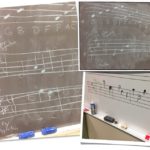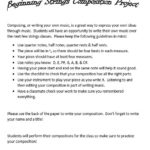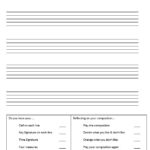
Reprinted with permission from the Spring 2018 issue of the Maryland Music Educator
Author’s Note: Since I only teach strings, my examples are from strings classes. One of the band teachers I work with has started doing similar activities with his students, so the activities…workfor both.
Why Composing?

Creating is now the first standard in our National Music Standards, encouraging students at all levels of ensemble playing to have the opportunity to create music on their instruments. The expectation that even our first-year instrumental students should be composing, improvising, preserving those ideas in standard musical notation, refining those ideas by editing them, and sharing their ideas can seem initially overwhelming to teachers. There is so much information to convey to students in the first year of instrumental music instruction: proper posture, making a good tone, how to perform notes, how to read music, performing different rhythms, and more. Finding the time in our short classes to also have students create their own music can seem like an impossible goal. However, incorporating opportunities for students to compose and improvise can also support students in learning the basic techniques of their instruments.
Giving students time to compose and improvise on their instruments gives them a chance to actually play around with their instruments. Children can learn a lot through play, and when they first enroll to learn to play an instrument, all they want to do is experiment with it and try all the strings. However, in an ensemble class we make them stop experimenting, and instead focus on techniques and playing just a few notes, all together. While this is an important skill to learn, giving them time to experiment with their instruments has benefits too.
Students will differentiate a composition assignment for themselves. Students who have mastered the notes they have been taught in class tend to be the ones who will try new notes and rhythms and write more complex works of music. Students who have been struggling with all the different notes can focus and write a composition that sounds interesting, including only those few notes with which they are most confident. By letting them choose what is in the works they write, students of all levels can have a successful experience writing and performing music.
Performing their own compositions is also a great way to have individual performances by every student in a large ensemble. Giving parents an opportunity to hear their child perform can be a very powerful retention tool, and also be a great experience for students and their family members. It is very different for parents to hear their child perform a solo than to hear the child as part of a huge group where they may not even be able to be seen. Since all of the compositions will be different, all of the children can shine. Unhelpful comparisons of one child’s ability to another are not as clear, since each child has the opportunity to write a composition they can excel at performing.
How Do You Start?
Small composition and improvisation activities can be worked into your class from the very first day. Once my beginners have learned how to hold the instrument, the names of their strings, and the DAD song (it’s as easy as it looks: just play D string, A string, D string), I have them make up their own open-string song. I encourage them to try playing different combinations of strings, then to write down their song on paper, and finally to share it with their neighbor. It’s a simple activity that only takes a few minutes, but it gets them in the mindset that they can make things up on their instrument from the beginning.
As classes continue and students learn more about their instruments and musical notation, there are lots of little ways to incorporate creativity. Most method books include exercises where students can compose and improvise in little ways such as writing an ending to a four-measure song, filling in some beats of a short song, or changing the rhythm of an exercise. Students can also have the opportunity to create their own rhythms to use with scales, or older students can experiment with adding articulations and dynamics of their choosing to scales and method book exercises. Giving students a chance to experiment with each new technique you teach them can reinforce that technique and allow them to be creative. Incorporating these little opportunities for composition and improvisation throughout the school year keeps students in a mindset that creation is a normal part of music.
Full Composition Project and Performance
When you are ready for the full composition project, I recommend beginning it in late January/early February. That gives you an opportunity to introduce new notes, rhythms, and musical concepts after the winter concert that students can then incorporate into their compositions. Once they have reinforced those new ideas by using them in their own works, there is still plenty of time in the year to prepare spring concert music.

For my beginning students, I always start with a class composition day. Students take turns adding notes on the board to our class composition. After each note is added, the whole class plays what we have so far, and decides if we like it and if we should keep it or want to change it. This procedure provides a good way for students to see how easy it is to compose a whole song from scratch and gives an opportunity to address ideas such as big leaps vs. stepwise motion and the use of repetition. It also reinforces the idea of playing what you write and editing it to make sure it is both playable and enjoyable.

The next class session after the class composition session, students start composing individually! I provide them a handout with detailed directions on the front, and space to write their composition on the back. In addition, I provide a checklist of the required parts of the composition and reflection directions. First-year students have very simple expectations: set up the work with a clef, key signature, & time signature, at least 4 measures, 4 beats in each measure, and use notes they know how to play. Second and third year students have more requirements that vary from year to year, depending on what we have been focusing on in class that year, and with a longer length requirement of eight measures. Additional requirements have included: writing in different time signatures; using notes on the G, C, or E string that were recently learned; including dynamics and articulations; and explaining in a written portion how the dynamics and articulations chosen expressed the emotion of their choice. If you would like to use my handouts in your own class, editable versions of the handouts can be found on my website: www.KimbleStrings.com/composition.
I give first-year students three class periods to compose. Second and third-year students get four class periods, so they have time to address the additional requirements and write a longer work. Some students will not need that much time, so it is important to have an alternate option available for those students who finish early. While students are working, I move around the room giving them advice and assistance with writing any new notes or rhythms they would like to include in their compositions.
Grading
Students spend a substantial amount of class time writing and editing their compositions, so grading their work is important. However, grading an eight-year-old’s composition on whether you liked it or not or how well they followed the rules of music theory would not be a fair expectation. I grade student compositions using a rubric that is based on the directions and checklist on the handout. I am basically looking for inclusion of all the requirements for the composition, not how musically they did so. Many students will get a good grade on the assignment, which is good. It’s nice for them to have a positive first composing experience. I do combine the composition grade with a performance grade for balance in grading, and to account for the importance of playing the composition with good posture and technique since it is a performance-based class.
Performance
Sharing a student’s composition is part of the National Music Standards and provides an excellent way to invite parents into your classroom. Once you have graded the compositions, give students a few days to practice their compositions at home before the big performance day. Split students into groups of 12-15 per 30-minute block and create a schedule of small group performances to send home to parents. Also include a reminder to parents who cannot attend the school performance to have their child perform the composition at home.
Begin each performance session with a description of the composing process so parents understand what they are about to hear, and then let the students perform! I have found it’s a nice touch to provide cookies and juice to students and parents once their performances are complete, and it’s a good incentive to get those first few volunteers to perform. I also recommend scanning all compositions into the computer before you grade them so that if students lose or forget their papers you can print them another copy, and they can still perform. Students are usually really excited to perform, and I have found that some parents who won’t attend an evening ensemble concert will come to hear their child perform solo.
Technology
There are many great computer programs that allow students to notate their compositions on a computer or tablet. If you have access to technology, giving your students time to make a final draft on a computer or even compose directly on the computer can be a great experience. Students love feeling that their works are now “real music” when they have neat, printed versions, and it can be interesting for them to hear the computer perform their compositions and compare that to how it sounds when they play them.
Have Fun!
Giving your students the opportunity to be creative with their instruments can be a really positive experience for you and for them. Some students will surprise you with really cool rhythms and others will entertain you with unique note combinations, but it’s always fun to see what your students will create!
About the Author:
Kathryn Kimble earned her Bachelor of Music degree in Viola Performance and Music Education at Ithaca College, and her Master of Music degree at the Peabody Conservatory of The Johns Hopkins University. A lifelong resident of Maryland, she currently teaches elementary school strings in Anne Arundel County. Comments are welcome and may be directed to the author at kakimble1@gmail.com.














